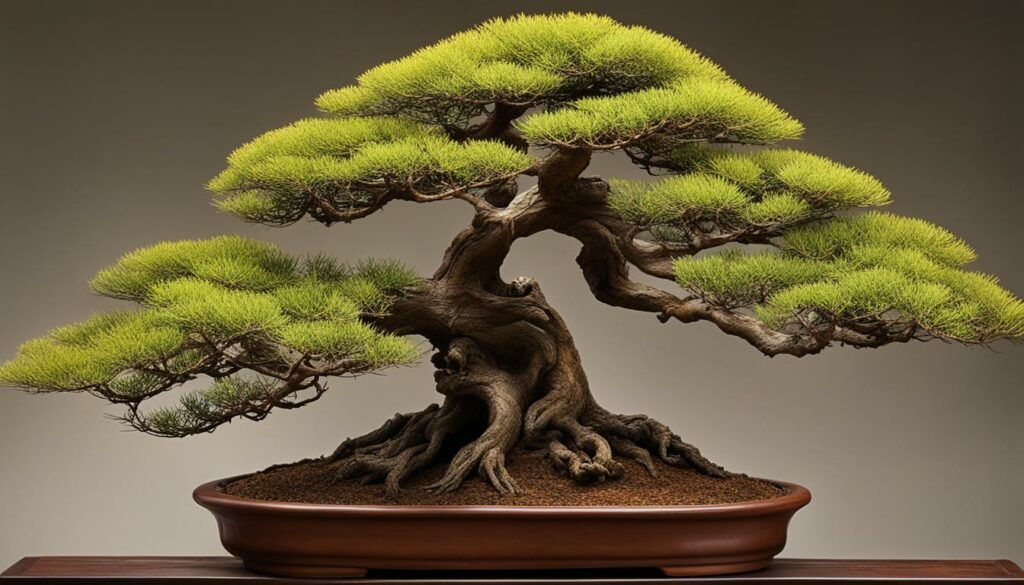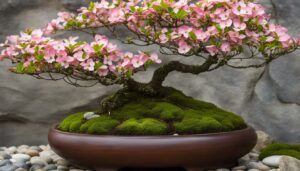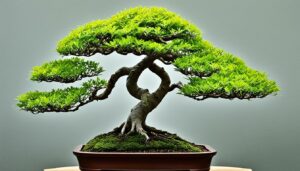Welcome to our article on bonsai tree species, where we delve into the captivating and unique qualities of the Acacia bonsai. The Bonsai Tree Species Acacia is an African bonsai known for its thorned branches and overall allure. In this section, we will highlight the resilient nature and beauty of this distinct bonsai tree species.
Key Takeaways:
- The Acacia bonsai is a resilient and striking tree species originating from Africa.
- This bonsai is known for its distinctive thorns and captivating beauty.
- We will explore the unique characteristics and care tips of the Acacia bonsai in the following sections.
- Stay inspired to embark on a rewarding bonsai journey with Acacia.
What Makes Acacia a Unique Bonsai Tree Species?
Acacia is a distinguished African bonsai with several unique characteristics that make it stand out from other bonsai species. One of the most noticeable features of Acacia is its distinctive thorns, which can be long, sharp, and intimidating.
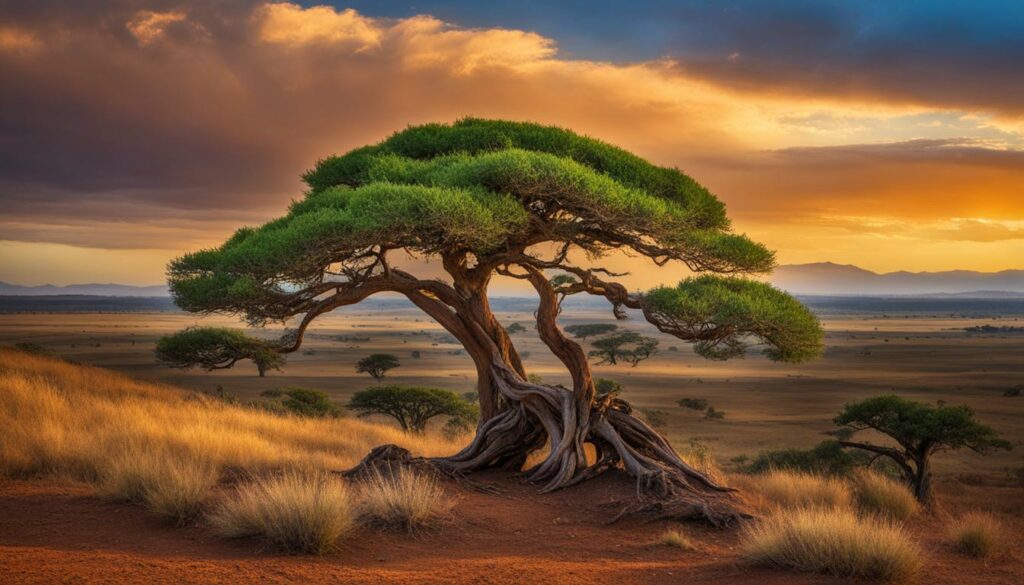
These thorns are vital to the tree’s survival in its natural habitat, acting as a deterrent against browsing wildlife and providing a defense against predators.
Another aspect that makes Acacia unique is its growth patterns. Bonsai growers can easily shape and train Acacia to create stunning displays, while still preserving the natural appearance of its African origins. Acacia is a drought-resistant species that thrives in sunny, arid regions, making it an excellent choice for bonsai hobbyists living in dry climates or those seeking a low-maintenance tree.
Overall, Acacia’s distinctive thorns, growth patterns, and resilience make it a captivating bonsai tree species prized by enthusiasts worldwide.
Origins of Acacia Bonsai Trees
Acacia bonsai trees have their roots in Africa, where they have been revered for centuries as symbols of strength, resilience, and beauty. The Acacia tree is an iconic symbol of Africa, with numerous species thriving across the continent’s various regions.
Over time, Acacia trees have been adapted into bonsai specimens, allowing enthusiasts to cultivate their own miniature versions of these stunning trees. The exact origins of Acacia bonsai cultivation are not known, but it is believed to have originated in Asia, where bonsai has a long and storied heritage.
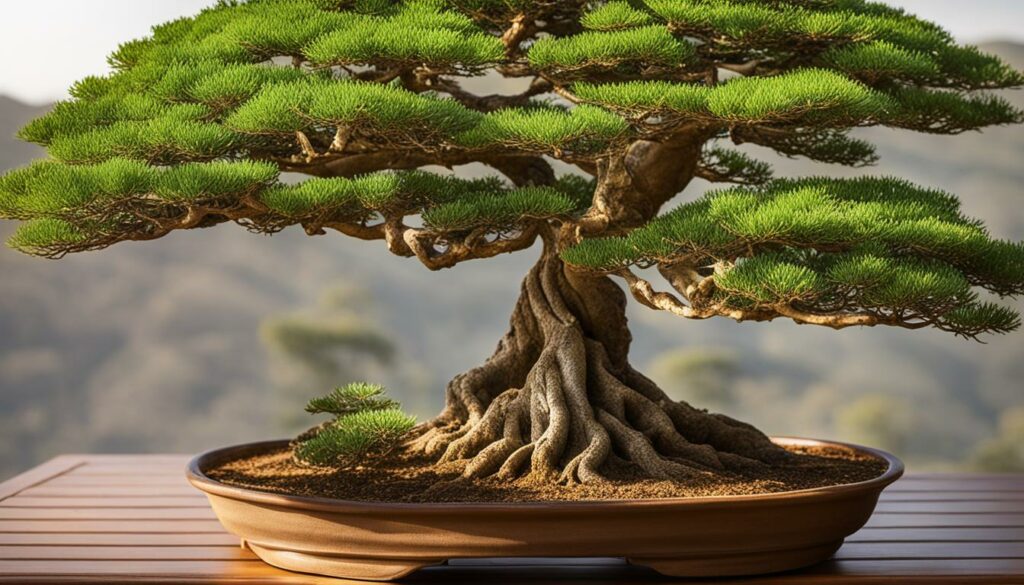
Today, Acacia bonsai trees are grown and admired around the world for their unique beauty and distinctive features. They continue to inspire new generations of bonsai enthusiasts to explore their African heritage and cultivate these incredible trees with care and devotion.
Growth Patterns and Care Tips for Acacia Bonsai Trees
Acacia bonsai trees display distinct growth patterns that require specific care practices to maintain their health and vitality. Proper care for African bonsai species such as the Acacia species can prevent pest infestation, diseases and promote more abundant growth. Here are some tips for cultivating your thorned bonsai:
Watering
Watering is perhaps the most critical aspect of growing Acacia bonsai trees because they are sensitive to both under and over-watering. Ensure the soil is moist but not overly wet to promote healthy growth.
Pruning
Pruning is necessary for thorned bonsai like the Acacia species. It helps maintain the tree’s shape and promotes the growth of new branches while removing dead or damaged ones. The best time for pruning is during the bonsai’s growth phase.
Repotting
Periodic repotting ensures that Acacia bonsai trees receive the necessary nutrients and adequate root space to aid growth. It is recommended to repot the bonsai annually during the spring season.
Exposure to Sunlight
Acacia bonsai trees require bright sunlight to thrive. Place your African bonsai species in an area with adequate sunlight and ensure that the amount of light received is consistent each day.
Following these care tips will result in a healthy and vibrant Acacia bonsai tree that will be the focal point of your bonsai collection.
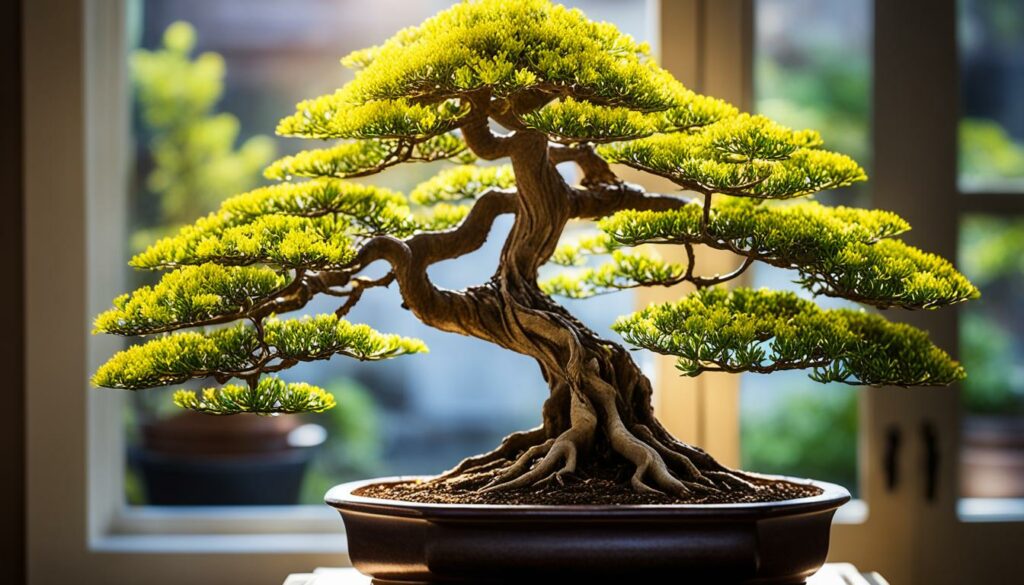
The Allure of Acacia Bonsai: Unique Thorns and Foliage
Acacia bonsai trees are much sought after for their distinctive thorns and foliage. The unique thorns on the bark of the tree branch out delicately, creating an eye-catching and captivating sight. Not only do these thorns add a bold texture, but they also enhance the aesthetic appeal of the tree’s silhouette.
The Acacia bonsai tree’s foliage is another reason for its allure. The leaves of the Acacia have a feathery texture, providing a unique contrast to the thorns. The foliage also changes colors throughout the year, with bright green leaves in the spring and summer, followed by rich reds and oranges in the fall.
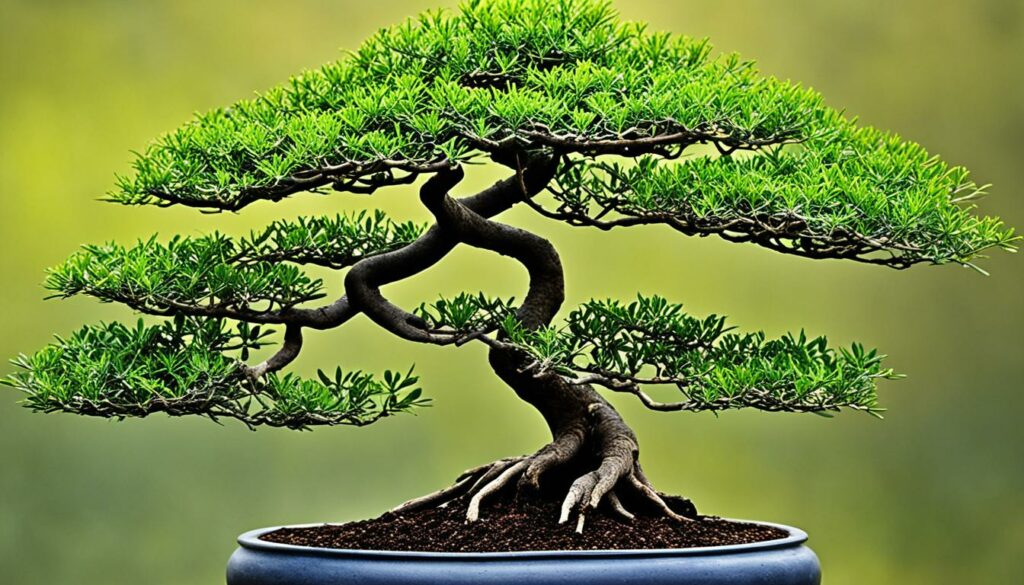
The contrast between the tree’s distinctive thorns and feather-like foliage is sure to provide a visually appealing spectacle. The Acacia bonsai tree is a perfect addition to any bonsai enthusiast’s collection and can add a unique appeal to any room or garden.
Acacia Bonsai Showcase: Varieties and Styles
Acacia bonsai trees come in various varieties and styles, each with its own charm and appeal. Whether you are a beginner or an experienced bonsai enthusiast, exploring the range of Acacia bonsai options can be a rewarding experience.
One popular variety is the Acacia tortilis, commonly known as the ‘Umbrella Tree.’ This variety is native to Africa and stands out with its unique umbrella-like canopy. Its striking appearance, combined with its resilience, makes it a popular choice for bonsai enthusiasts.
Another variety is the Acacia gerrardii, also known as the ‘Red Thorn.’ This variety features stunning red thorns that contrast beautifully against its green foliage, making it an eye-catching addition to any bonsai collection.
For those who prefer a more dramatic look, the Acacia horrida, or ‘Horrid Thorn,’ is an excellent option. This particular variety boasts long, sharp thorns that give it a fearsome appearance, which can be softened by careful pruning and training.
Lastly, the Acacia burkei, or ‘Black Monkey Thorn,’ features dark, gnarled bark and twisted branches. This variety is prized for its unique character and can be trained into several styles, including the cascade and broom styles.
When it comes to styles, Acacia bonsai trees can be trained in a variety of shapes, including the informal upright, slanting, and windswept styles. These styles can be achieved by careful pruning and wiring, bringing out the natural beauty of the Acacia bonsai.
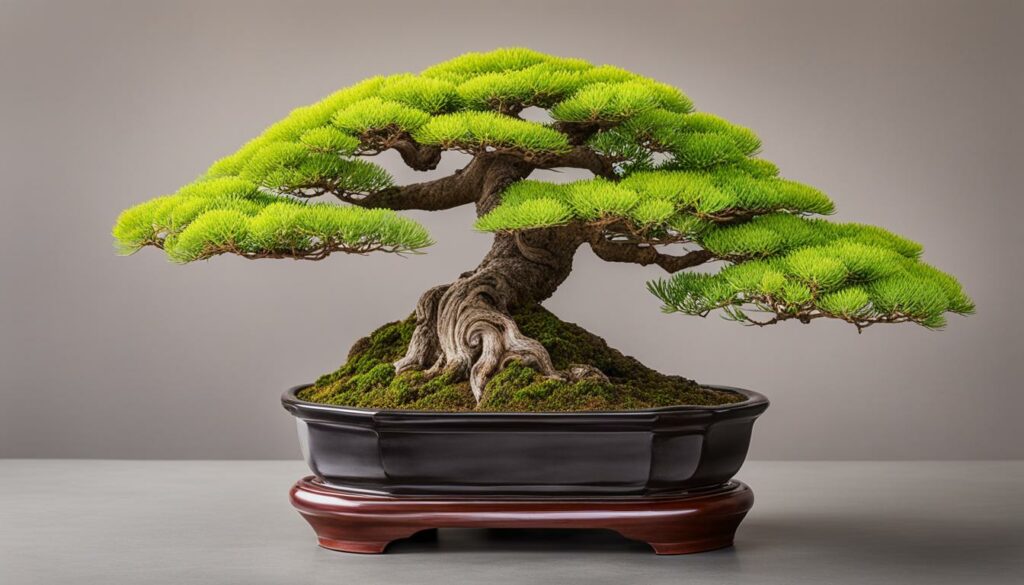
“Seeing the wide variety of Acacia bonsai trees and styles has inspired me to try something new with my own collection!” – Bonsai Enthusiast
Challenges and Benefits of Growing Acacia Bonsai
Growing Acacia bonsai trees can be a rewarding journey, but it also comes with its share of challenges. Understanding these challenges and how to address them can help you cultivate healthier, more vibrant Acacia bonsai specimens.
Challenges of Growing Acacia Bonsai
One of the biggest challenges of growing Acacia bonsai is their thorns. These thorns can be sharp and long, making it difficult to prune and work with the tree. Additionally, the thorns can cause injury if not handled with care.
Acacia bonsai trees are also vulnerable to certain pests and diseases, such as spider mites and root rot. Preventative measures, such as proper watering and healthy soil, can go a long way in avoiding these issues.
Benefits of Growing Acacia Bonsai
Despite these challenges, growing Acacia bonsai trees can be a rewarding experience. Their unique thorns and foliage make them stand out among other bonsai species, and they are known for their resilience in hot and dry climates.
Acacia bonsai trees also have cultural and symbolic significance in many parts of Africa, making them a valuable addition to any bonsai collection. Their distinct beauty and history make them a conversation piece and a source of inspiration for many bonsai enthusiasts.
“Acacia bonsai trees are known for their resilience in hot and dry climates.”
Acacia Bonsai in Cultural and Symbolic Contexts
Acacia bonsai holds a special place in various cultures and traditions, each with its unique interpretations and symbolism. In ancient Egyptian culture, Acacia was a symbol of rebirth and immortality. The tree’s hard wood and thorned branches were used as protective shields for the pharaoh’s tombs. On the other hand, in African folklore, Acacia was a symbol of spiritual enlightenment and represented the connection between humans and the divine forces of nature.
The Japanese art of bonsai cultivation also values Acacia as a valuable symbol of determination and resilience. Acacia’s thorns and long roots symbolize a rough path in life; however, with continued perseverance and patience, one can overcome these challenges and thrive, just like the Acacia tree.
“In bonsai, the tree is shaped to mimic the nature of man: perfect imperfection”
Many bonsai enthusiasts are drawn to Acacia’s unique appearance and symbolism, making it a popular choice for bonsai cultivation worldwide.
The Significance of Acacia Bonsai in Different Cultures and Traditions
To better understand the significance of Acacia bonsai in various cultures and traditions, let’s take a closer look at its symbolism.
| Culture/Tradition | Symbolism of Acacia |
|---|---|
| Egyptian | Rebirth, immortality, and protective power |
| African | Spiritual enlightenment, connection with nature |
| Japanese | Determination, resilience, and perfect imperfection |
Acacia bonsai’s cultural and symbolic significance adds depth to its overall appeal, making it a unique and treasured specimen in the world of bonsai cultivation.
Acacia Bonsai Tree Species: Frequently Asked Questions
As you embark on your Acacia bonsai tree journey, you may have some questions. Here are some common inquiries and their answers:
How do I propagate Acacia bonsai trees?
Acacia bonsai trees can be propagated through seeds, cuttings, or air layering. Seeds provide the most diversity, but cuttings and layering offer a faster process.
What pests should I look out for when growing Acacia bonsai trees?
Acacia bonsai trees are susceptible to aphids, spider mites, mealybugs, and scale insects. Regular inspections and appropriate treatments will help prevent and combat these pests.
Can I wire and style my Acacia bonsai tree?
Yes, Acacia bonsai trees are pliable and easy to wire and style. However, be gentle to avoid damaging the tree.
“Acacia bonsai trees are a treat to work with. I appreciate their unique characteristics and love how they can transform any space into a natural haven.” – Bonsai enthusiast, Susan Matthews
Growing Acacia Bonsai: A Rewarding Journey
If you are looking for a rewarding bonsai journey, growing the Acacia bonsai tree species is an excellent choice. Acacia is an African bonsai tree that is known for its durability, beauty, and unique thorns. With the proper care and attention, your Acacia bonsai will thrive and bring years of joy.
What makes growing an Acacia bonsai so rewarding? For starters, it is an incredibly resilient species that can withstand a range of growing conditions. Acacia’s thorns are an added draw, bringing a distinctive aesthetic appeal that sets it apart from other bonsai tree species.
When it comes to growing Acacia, it is essential to provide it with proper care and attention. As an African bonsai, Acacia thrives in sunny and warm conditions. Ensure that your Acacia receives plenty of sunlight and is not overwatered, as it can be sensitive to root rot.
Pruning is also crucial for maintaining the health and shape of your Acacia bonsai. Regular pruning will promote healthy growth and the development of the distinctive thorns that make Acacia so visually striking. Repotting may be necessary every few years, depending on the growth rate of your bonsai.
Overall, growing Acacia bonsai trees is a fulfilling experience that offers both practical benefits and aesthetic appeal. With its natural resilience, unique aesthetic, and easy-to-manage growth patterns, Acacia is the perfect choice for both novice and experienced bonsai enthusiasts.
FAQ
What makes Acacia a unique bonsai tree species?
Acacia stands out as a bonsai tree species due to its origins in Africa and its distinct growth patterns. It is known for its thorns and captivating allure, which adds to its overall appeal.
Where do Acacia bonsai trees originate from?
Acacia bonsai trees have their origins in Africa. They have been cultivated and adapted as bonsai specimens throughout history, showcasing their resilience and beauty.
How should I care for Acacia bonsai trees?
To maintain the health and vitality of Acacia bonsai trees, it is important to water them properly, prune them regularly, repot them when necessary, and provide them with adequate sunlight.
What is unique about Acacia bonsai’s thorns and foliage?
Acacia bonsai trees have unique thorns and foliage that contribute to their aesthetic appeal. These characteristics make them visually striking and add to their overall allure.
Can I shape and train Acacia bonsai trees in different styles?
Yes, Acacia bonsai trees can be shaped and trained in various styles. They are versatile and can be transformed into stunning displays, allowing bonsai enthusiasts to exercise their creativity.
What are the challenges and benefits of growing Acacia bonsai trees?
Growing Acacia bonsai trees can present challenges, such as proper watering and pest control. However, the rewards are manifold, including the satisfaction of cultivating a resilient and visually appealing bonsai species.
What is the cultural and symbolic significance of Acacia bonsai trees?
Acacia bonsai trees hold cultural and symbolic significance in different contexts. They are valued in various cultures and traditions for their beauty, resilience, and unique characteristics.
What are some frequently asked questions about Acacia bonsai trees?
Commonly asked questions about Acacia bonsai trees include propagation methods, pest control techniques, and styling tips. These questions aim to provide valuable information for bonsai enthusiasts at all levels of experience.
Why is growing Acacia bonsai a rewarding journey?
Growing Acacia bonsai trees offers a rewarding journey due to their resilience, beauty, and uniqueness. Their striking thorns and foliage, along with their African heritage, make them a captivating and fulfilling species to cultivate.
